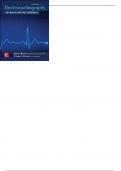Exam (elaborations)
Test Bank For Electrocardiography for Healthcare Professionals 5Th Edition By Booth
- Institution
- Electrocardiography For Healthcare - Test Bank
Electrocardiography for Healthcare Professionals, 5e (Booth) Chapter 3 The Electrocardiograph 1) The ECG waveform is indicative of: A) how the heart is functioning electrically. B) abnormal heart valve conditions. C) the contraction of heart muscles. D) the heart's pumping capability. Answer: ...
[Show more]



